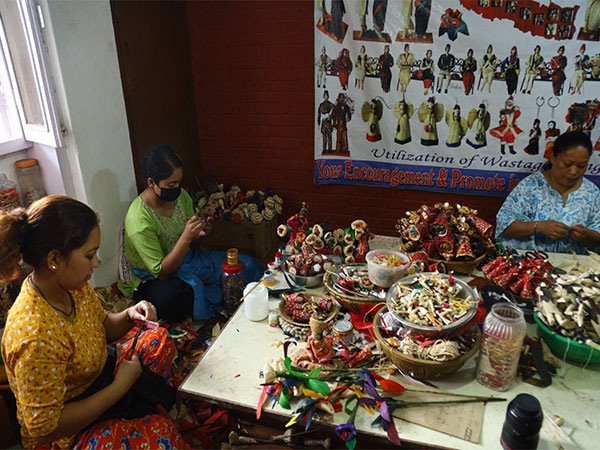Tsuktiben Jamir
In the bustling alleyways of Patan, an ancient city in Nepal, Laxmi Nakarmi and her sisters have embarked on a creative journey, transforming corn husks into stunning works of art. What began as a simple hobby inspired by an article about corn husk decorations in the United States has now blossomed into a thriving business, fuelled by the sisters’ passion and the increasing demand for their unique creations.
“They were making art from the corn husk, which was loosely wrapped art depicting their culture; being inspired by that, I started it as a hobby and focused on Nepali culture. At first, I used to make small pieces of art and had no thoughts about starting it as a business. Once I read that story in the magazine, the idea to start with Nepali culture was also pioneered. I always had that thought on my mind about recycling things which we throw out, and the magazine drove me towards it,” Laxmi told ANI.
Laxmi and her committed team carefully revive the neglected agricultural by-product from their cosy rented apartment. In Nepal, maise is a significant cash crop that prospers due to the country’s varied topography and favourable weather. Nevertheless, despite their abundance, maise scraps are frequently thrown away or allowed to rot in dump yards. On the other hand, the sisters recognised the potential in these underutilised components. They set out to catch people’s imaginations through their creative use of maise husks by turning them into beautiful works of art.
Laxmi recalls the early days and the first responses to her artwork. Upon hearing the word “corn husk,” many would not be impressed, and others would even think it was just paper. She persisted nonetheless, determined to alter these opinions. Laxmi would travel to communities to persuade people to give her maize husks so she could use them for art instead of throwing them away. Corn husk art gradually acquired popularity and respect as attitudes changed.
Laxmi initially narrowed her focus on creating little works of art, especially dolls, which were sold in Kathmandu handicraft shops. She broadened the scope of her work throughout time, embracing the ethnic variety of Nepal in her works. Each doll is painstakingly created to accurately represent the cultural history of several ethnicities, including Newari, Khas-Pahadi, Raute, Kirat, Sherpa, and Jhakri. These maise husk dolls have intricate face details, vivid colours, and traditional clothing.
The entire process is quite fascinating. When they arrive at the workshop, the husks are soaked in water to make them more supple. The husks are then submerged in boiling water, much like dying clothing, to get the perfect colours corresponding to the cultural group they represent. While tones of red and green adorn the Pahadi-Khas dolls, reflecting the Nepali hill community’s Gunyo Cholo, dark contrast colours bring out the character of Newari dolls, exhibiting the traditional Haku Patasi costume.
At the heart of Laxmi’s venture lies a commitment to women’s empowerment. The workshop employs women with different abilities, providing them with meaningful work that requires less physical labour. Sangita Sunuwar, a deaf woman who has been part of the workshop for years, attests to its positive impact on her life and family. Through her sign language, Sangita expresses her gratitude for the opportunity to learn and develop her skills, finding security and happiness in her work.
Beyond empowering women and repurposing corn husks, these art pieces also play a vital role in preserving Nepali culture. There is a danger that these creative traditions will disappear as the new generation becomes less aware of traditional crafts and their importance to Nepal. However, The Sisters’ Creation represents dedication to maintaining this distinctive art form, ensuring its timeless essence continues and may be transmitted to future generations.





